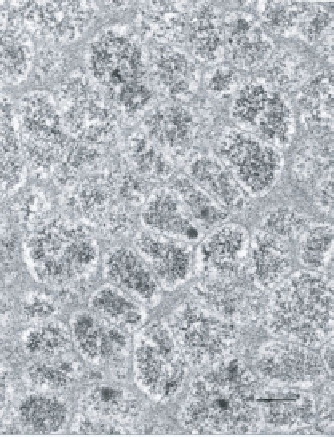Information Technology Reference
In-Depth Information
Figure 9.9
Electron micrograph
of vesicles formed from bands of a
polytene chromosome. Bar
=
1
µ
m.
Courtesy of K. G. Murti.
of each gene-containing molecule. The new macronucleus and the new mi-
cronucleus divide, creating the mature complement of two macronuclei and
two micronuclei and completing the 3-day process. At this point the cell re-
sumes proliferation if food is available. The organism cannot mate again until
it has undergone 20-30 cell divisions. The molecular basis of this sexually
immature stage is unknown. If food is unavailable at the end of macronuclear
development, the stichotrich may form a cyst. A cyst consists of a condensed,
metabolically inert stichotrich inside a thick, stiff protective wall. In some
species the cysts can be dried, frozen, and stored for many years. Brought
to an appropriate temperature (e.g., 23°C) and supplied with food organisms,
cysts hatch in 12-24 h, and the released ciliates resume proliferation.
There are major questions about the conversion of micronuclear DNA to
macronuclear DNA for which we do not yet have satisfactory answers. A cru-
cial issue is how the cell identifies the ends of gene segments in order to excise
the genes from chromosomal DNA. The 50 bp at both ends of gene segments
have an unusual nucleotide composition; one chain of the DNA is purine rich,
and the other is pyrimidine rich [8], which conceivably serves as a signal for
DNA cutting to excise the genes. However, nothing is known about the en-
zyme(s) that might recognize the 50 bp of unusual nucleotide composition
and then carry out gene excision. Another important question is how the cell
identifies spacer DNA for destruction and gene DNA for preservation. After
gene segments are excised from micronuclear DNA, they are replicated to about
1000 copies each. We do not know how the cell is able to count the number

